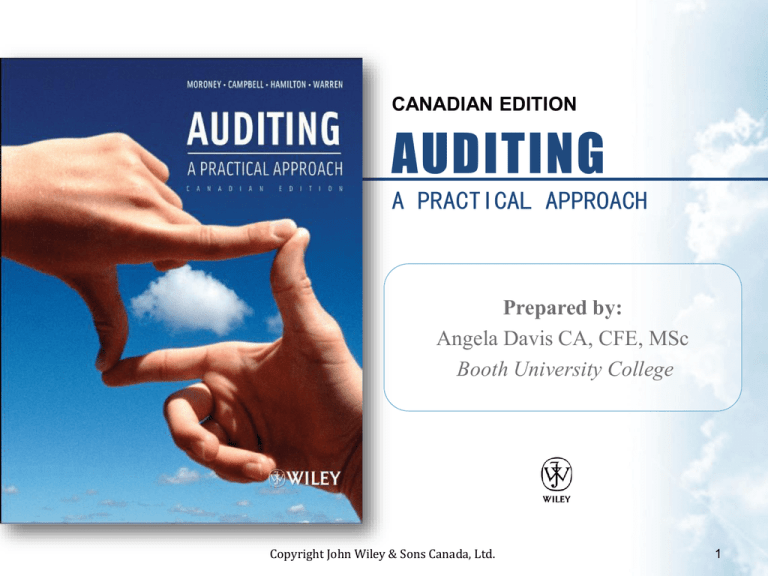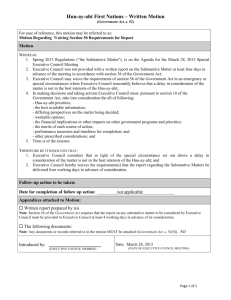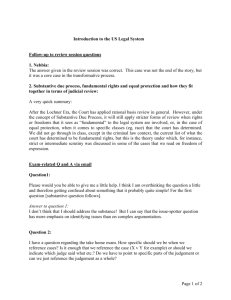
CANADIAN EDITION
AUDITING
A PRACTICAL APPROACH
Prepared by:
Angela Davis CA, CFE, MSc
Booth University College
Copyright John Wiley & Sons Canada, Ltd.
1
CHAPTER 11
SUBSTANTIVE TESTING AND INCOME
STATEMENT ACCOUNTS
LEARNING OBJECTIVES
1. Explain the relationship between the overall risk assessment for a
significant account and the extent and timing of substantive
procedures, and the differences between auditing income statement
and balance sheet accounts
2. Design and understand how to execute substantive procedures to
address audit risk related to revenue
3. Design and understand how to execute substantive procedures to
address audit risk related to cost of sales and other significant
expenses
4. Understand how to assess the results of the substantive procedures
to determine whether additional substantive tests are necessary
Copyright John Wiley & Sons Canada, Ltd.
2
Risk and substantive
procedures
1. Differences between auditing income statement
and balance sheet accounts
•
•
•
Balance sheet accounts typically represent only
recent transactions, or one-off transactions
Income statement accounts reflect sum of entire
reporting period transactions
Difference in nature of account is reflected in
difference in testing
–
Typically use analytical procedures for income
statement accounts rather than confirmations etc
Copyright John Wiley & Sons Canada, Ltd.
3
Risk and substantive
procedures
2. Extent of substantive procedures
•
As discussed for balance sheet accounts,
extent of testing determined by risk assessment
for each significant account or disclosure
–
–
High IR, CR: do not rely on and test controls, use
significant amount of substantive testing to reduce
DR
Low IR, CR: testing controls shows them to be
effective, limited substantive testing required
3. Timing of substantive procedures
–
Dependent on risk assessment, can perform some
types of work prior to year-end, leverage off internal
audit etc
Copyright John Wiley & Sons Canada, Ltd.
4
Substantive testing Revenue
• Sales is usually very significant account
– Pressure to achieve sales targets creates risk of
overstatement
• High overall inherent risk, e.g. manipulation,
fraud
– Also significant because:
• Material size
• High volume of transactions
– Auditors usually either use only substantive
testing techniques, or use controls testing
supplemented with high-level analytical
procedures
Copyright John Wiley & Sons Canada, Ltd.
5
Substantive testing –
Revenue cont’d
– Most important assertions: occurrence, accuracy,
cut-off
– Occurrence
• Test recorded sales are bona fide and have occurred
– Accuracy
• Sales are recorded at correct amount, not overstated
– Cut-off
• Risk that sales occur after year-end are recorded
early
– Completeness is not usually significant, except if
pressure to increase next year’s sales
Copyright John Wiley & Sons Canada, Ltd.
6
Substantive testing –
Revenue cont’d
– Service revenue requires testing projects
delivered to customers, or in progress
– Interest, dividend revenue – recalculate, check
bank statements
– Other items not usually material
Copyright John Wiley & Sons Canada, Ltd.
7
Substantive testing –
Revenue cont’d
Table 11.2
Copyright John Wiley & Sons Canada, Ltd.
8
Substantive testing –
Revenue cont’d
• Processes impacting sales revenue
– Sales and sales returns and allowances
– Consider evidence from interim testing, control
testing phase
– If substantive testing required, use detailed
testing such as vouching, tracing of documents,
recalculating pricing and discounts, testing
postings etc
Copyright John Wiley & Sons Canada, Ltd.
9
Substantive testing –
Revenue cont’d
Table 11.3
Copyright John Wiley & Sons Canada, Ltd.
10
Substantive testing –
Revenue cont’d
Table 11.3 (continued)
Copyright John Wiley & Sons Canada, Ltd.
11
Substantive testing –
Revenue cont’d
Table 11.3
(continued)
Copyright John Wiley & Sons Canada, Ltd.
12
Substantive
testing –
Revenue
cont’d
Table 11.4
Copyright John Wiley & Sons Canada, Ltd.
13
Substantive testing – Cost
of sales and expenses
• Cost of sales and expenses are significant
accounts in income statement
• Major risk relates to understatement
• Key assertions are accuracy, completeness and
cut-off
– Accuracy
• Verify by vouching recorded amounts to
documents or underlying account, e.g.
– Depreciation – tested as part of verifying PPE balance
– Bad debts – part of verifying receivables balance
Copyright John Wiley & Sons Canada, Ltd.
14
Substantive testing – Cost
of sales, expenses cont’d
– Accuracy cont’d
• Cost of sales is verified to:
– Opening inventory balance (last year closing balance)
– Purchases and payables
– Closing inventory balance part of inventory valuation
• Purchases typically subjected to additional
testing through controls testing, and if necessary,
vouching to supplier documentation
– Sophisticated analytical procedures can be used,
based on client’s production processes
Copyright John Wiley & Sons Canada, Ltd.
15
Substantive testing – Cost
of sales, expenses cont’d
– Completeness and cut-off
• Assertions combined – auditor to verify that client
has not understated expenses and cost of sales
by deferring recording expenses to next period
– Examine invoices around year-end to verify dates
– Classification can be important for special
disclosure requirements
• E.g. interest expense, depreciation
– Occurrence not typically significant
Copyright John Wiley & Sons Canada, Ltd.
16
Substantive testing – Cost
of sales, expenses cont’d
Table 11.5
Copyright John Wiley & Sons Canada, Ltd.
17
Substantive testing – Cost
of sales, expenses cont’d
• Processes impacting on costs and expenses
– Substantive testing of purchases and payroll
usually undertaken only if controls not effective,
or if more efficient to test substantively
• Testing of balances – some procedures
ordinarily always performed, others if risk
assessment warrants
Copyright John Wiley & Sons Canada, Ltd.
18
Substantive testing – Cost
of sales, expenses cont’d
Copyright John Wiley & Sons Canada, Ltd.
19
Substantive testing – Cost
of sales, expenses cont’d
Table 11.7
Copyright John Wiley & Sons Canada, Ltd.
20
Substantive testing – Cost
of sales, expenses cont’d
Table 11.7 (continued)
Copyright John Wiley & Sons Canada, Ltd.
21
Substantive testing – Cost
of sales, expenses cont’d
• Payroll generally one of the more significant
expenses
• Auditor usually test the controls over the payroll
cycle and then performs substantive analytical
procedures
• If payroll outsourced auditor still responsible for
auditing payroll related balances
• Many payroll services will issue an audit report
on their operations which the clients auditors
can then rely on
Copyright John Wiley & Sons Canada, Ltd.
22
Substantive testing – Cost
of sales, expenses cont’d
Table 11.6
Copyright John Wiley & Sons Canada, Ltd.
23
Substantive
testing –
Cost of
sales,
expenses
cont’d
Table 11.8
Copyright John Wiley & Sons Canada, Ltd.
24
Assessing results of
substantive procedures
• Other costs or expenses that could be significant
include:
•
•
•
•
•
Administration costs
Selling expenses
Audit fees
Advertising and marketing costs
Impairment charges
– Nature of tests similar to purchases and payroll
– Use risk assessment based on knowledge of
client and professional judgement to determine
timing and extent of testing
Copyright John Wiley & Sons Canada, Ltd.
25
Assessing results, cont’d
• Auditor’s objective is to determine if there are
misstatements within the account balance and to
quantify the amount of any misstatement
– If error identified:
•
•
•
•
Understand why it occurred
Consider increase to sample size
Consider additional testing
Continue testing until error can be accurately
quantified or balance fully tested to ensure no
error remains
Copyright John Wiley & Sons Canada, Ltd.
26
Copyright
Copyright © 2012 John Wiley & Sons Canada, Ltd. All rights
reserved. Reproduction or translation of this work beyond that
permitted by Access Copyright (The Canadian Copyright
Licensing Agency) is unlawful. Requests for further information
should be addressed to the Permissions Department, John
Wiley & Sons Canada, Ltd. The purchaser may make back-up
copies for his or her own use only and not for distribution or
resale. The author and the publisher assume no responsibility
for errors, omissions, or damages caused by the use of these
programs or from the use of the information contained herein.
Copyright John Wiley & Sons Canada, Ltd.
27





